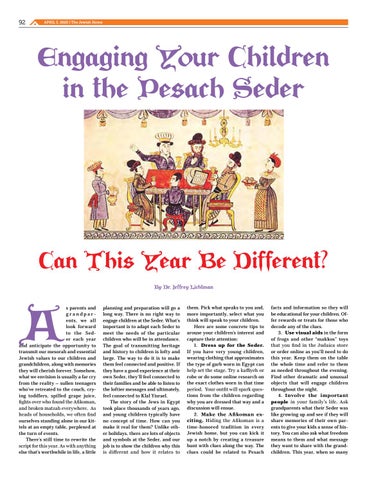92 84
APRIL 3, 2020 | The Jewish Home OCTOBER 29, 2015 | The Jewish Home
Engaging Your Children in the Pesach Seder
Can This Year Be Different? By Dr. Jeffrey Lichtman
A
s parents and grandparents, we all look forward to the Seder each year and anticipate the opportunity to transmit our mesorah and essential Jewish values to our children and grandchildren, along with memories they will cherish forever. Somehow, what we envision is usually a far cry from the reality – sullen teenagers who’ve retreated to the couch, crying toddlers, spilled grape juice, fights over who found the Afikoman, and broken matzah everywhere. As heads of households, we often find ourselves standing alone in our kittels at an empty table, perplexed at the turn of events. There’s still time to rewrite the script for this year. As with anything else that’s worthwhile in life, a little
planning and preparation will go a long way. There is no right way to engage children at the Seder. What’s important is to adapt each Seder to meet the needs of the particular children who will be in attendance. The goal of transmitting heritage and history to children is lofty and large. The way to do it is to make them feel connected and positive. If they have a good experience at their own Seder, they’ll feel connected to their families and be able to listen to the loftier messages and ultimately, feel connected to Klal Yisrael. The story of the Jews in Egypt took place thousands of years ago, and young children typically have no concept of time. How can you make it real for them? Unlike other holidays, there are lots of objects and symbols at the Seder, and our job is to show the children why this is different and how it relates to
them. Pick what speaks to you and, more importantly, select what you think will speak to your children. Here are some concrete tips to arouse your children’s interest and capture their attention: 1. Dress up for the Seder. If you have very young children, wearing clothing that approximates the type of garb worn in Egypt can help set the stage. Try a kaffiyeh or robe or do some online research on the exact clothes worn in that time period. Your outfit will spark questions from the children regarding why you are dressed that way and a discussion will ensue. 2. Make the Afikoman exciting. Hiding the Afikoman is a time-honored tradition in every Jewish home, but you can kick it up a notch by creating a treasure hunt with clues along the way. The clues could be related to Pesach
facts and information so they will be educational for your children. Offer rewards or treats for those who decode any of the clues. 3. Use visual aids in the form of frogs and other “makkos” toys that you find in the Judaica store or order online as you’ll need to do this year. Keep them on the table the whole time and refer to them as needed throughout the evening. Find other dramatic and unusual objects that will engage children throughout the night. 4. Involve the important people in your family’s life. Ask grandparents what their Seder was like growing up and see if they will share memories of their own parents to give your kids a sense of history. You can also ask what freedom means to them and what message they want to share with the grandchildren. This year, when so many





















